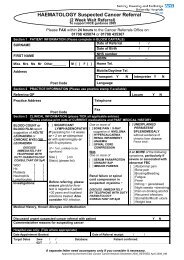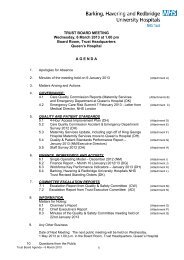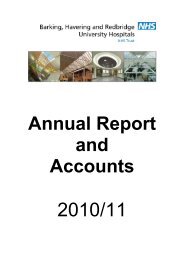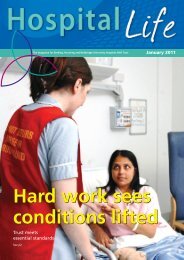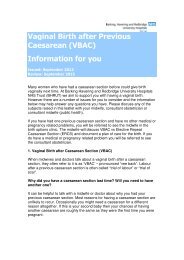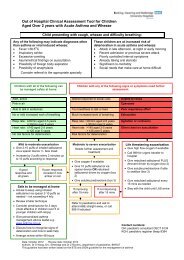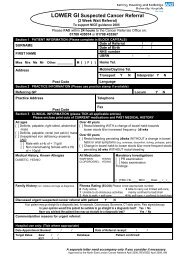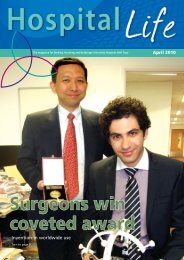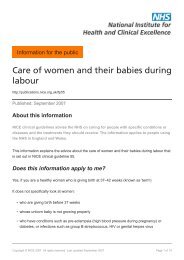A breech baby at the end of pregnancy Information for you
A breech baby at the end of pregnancy Information for you
A breech baby at the end of pregnancy Information for you
You also want an ePaper? Increase the reach of your titles
YUMPU automatically turns print PDFs into web optimized ePapers that Google loves.
A <strong>breech</strong> <strong>baby</strong> <strong>at</strong> <strong>the</strong> <strong>end</strong> <strong>of</strong> <strong>pregnancy</strong><br />
In<strong>for</strong>m<strong>at</strong>ion <strong>for</strong> <strong>you</strong><br />
Published: September 2012<br />
Review: September 2015<br />
Wh<strong>at</strong> is <strong>breech</strong><br />
Breech means th<strong>at</strong> <strong>you</strong>r <strong>baby</strong> is lying bottom first or feet first in <strong>the</strong> womb (uterus)<br />
instead <strong>of</strong> in <strong>the</strong> usual head first position. In early <strong>pregnancy</strong>, <strong>breech</strong> is very<br />
common. As <strong>pregnancy</strong> continues, a <strong>baby</strong> usually turns n<strong>at</strong>urally into <strong>the</strong> head first<br />
position. Between 37 and 42 weeks (term), most babies are lying head first ready to<br />
be born.<br />
Three in every 100 (3%) babies are <strong>breech</strong> <strong>at</strong> <strong>the</strong> <strong>end</strong> <strong>of</strong> <strong>pregnancy</strong>.<br />
A <strong>breech</strong> <strong>baby</strong> may be lying in one <strong>of</strong> <strong>the</strong> following positions:<br />
Why is my <strong>baby</strong> <strong>breech</strong><br />
Sometimes it is just a m<strong>at</strong>ter <strong>of</strong> chance th<strong>at</strong> <strong>you</strong>r <strong>baby</strong> does not turn and remains in<br />
<strong>the</strong> <strong>breech</strong> position. At o<strong>the</strong>r times certain factors make it difficult <strong>for</strong> <strong>you</strong>r <strong>baby</strong> to<br />
turn during <strong>pregnancy</strong>. These might include <strong>the</strong> amount <strong>of</strong> fluid in <strong>the</strong> womb (ei<strong>the</strong>r<br />
too much or too little), <strong>the</strong> position <strong>of</strong> <strong>the</strong> placenta or if <strong>the</strong>re is more than one <strong>baby</strong> in<br />
1
<strong>the</strong> womb. The vast majority <strong>of</strong> <strong>breech</strong> babies are born healthy. For a few babies,<br />
<strong>breech</strong> may be a sign <strong>of</strong> a problem with <strong>the</strong> <strong>baby</strong>. All <strong>breech</strong> babies (<strong>at</strong> 36 weeks or<br />
after) should have an ultrasound examin<strong>at</strong>ion <strong>of</strong> <strong>the</strong> hips.<br />
Wh<strong>at</strong> can be done<br />
If <strong>you</strong> are 36 weeks pregnant and <strong>the</strong> <strong>baby</strong> is in a <strong>breech</strong> position, <strong>you</strong>r obstetrician<br />
or midwife should discuss external cephalic version (ECV).<br />
Turning <strong>the</strong> <strong>baby</strong> to a head-down position, which is called ECV, is an altern<strong>at</strong>ive to<br />
planned caesarean section. ECV is a simple procedure and takes about five to ten<br />
minutes; ECV is usually uncom<strong>for</strong>table but not a painful procedure. It does not need<br />
any <strong>for</strong>m <strong>of</strong> anaes<strong>the</strong>sia. However, <strong>you</strong> should only have a light breakfast and <strong>the</strong>n<br />
not e<strong>at</strong> or drink again until after <strong>the</strong> ECV. ECV is per<strong>for</strong>med after 36 weeks as <strong>the</strong><br />
<strong>baby</strong> <strong>of</strong>ten turns without help be<strong>for</strong>e this time.<br />
ECV is per<strong>for</strong>med in <strong>the</strong> labour ward. An appointment is arranged in advance. On<br />
admission an ultrasound scan is per<strong>for</strong>med to check <strong>the</strong> <strong>baby</strong>’s position and <strong>the</strong><br />
amount <strong>of</strong> fluid around <strong>the</strong> <strong>baby</strong>. Your <strong>baby</strong>’s heart will be monitored <strong>for</strong> about thirty<br />
minutes. If all is well a drug called terbutaline will be given by injection which relaxes<br />
<strong>the</strong> womb. A doctor will try and turn <strong>the</strong> <strong>baby</strong> by pushing gently on <strong>you</strong>r tummy. At<br />
<strong>the</strong> <strong>end</strong> ano<strong>the</strong>r ultrasound scan is per<strong>for</strong>med to check <strong>the</strong> position <strong>of</strong> <strong>you</strong>r <strong>baby</strong> and<br />
<strong>you</strong>r <strong>baby</strong>’s heart will be monitored again to make sure th<strong>at</strong> he/she is not distressed.<br />
You should expect to be on <strong>the</strong> labour ward <strong>for</strong> about 2 hour’s altoge<strong>the</strong>r.<br />
Wh<strong>at</strong> is <strong>the</strong> benefit <strong>of</strong> per<strong>for</strong>ming ECV<br />
ECV is successful in about 40-50% <strong>of</strong> cases and it is unusual <strong>for</strong> <strong>the</strong> <strong>baby</strong> to turn<br />
back again. If it is successful <strong>you</strong> can have a normal labour. If ECV is not<br />
successful <strong>you</strong> can discuss <strong>you</strong>r options with <strong>you</strong>r obstetrician and midwife.<br />
Will I be suitable <strong>for</strong> an <strong>at</strong>tempt <strong>at</strong> ECV<br />
We do not <strong>at</strong>tempt ECV if <strong>you</strong> have a twin <strong>pregnancy</strong> or are to be delivered by<br />
caesarean section <strong>for</strong> o<strong>the</strong>r reasons, or <strong>you</strong> have had significant vaginal bleeding.<br />
Is ECV safe and wh<strong>at</strong> are <strong>the</strong> risks<br />
ECV is a safe procedure. In <strong>the</strong> unlikely event th<strong>at</strong> <strong>the</strong>re are any signs <strong>of</strong> <strong>you</strong>r <strong>baby</strong><br />
becoming distressed, which is very unusual, we could deliver <strong>the</strong> <strong>baby</strong> very quickly.<br />
A small amount <strong>of</strong> <strong>baby</strong>’s blood can pass into <strong>the</strong> mo<strong>the</strong>r’s blood during <strong>the</strong><br />
procedure and <strong>for</strong> this reason rhesus neg<strong>at</strong>ive mo<strong>the</strong>rs are given an injection <strong>of</strong><br />
AntiD.<br />
Wh<strong>at</strong> should I expect afterwards<br />
You might experience slight discom<strong>for</strong>t after <strong>the</strong> procedure if it is successful;<br />
however, <strong>you</strong> may feel more com<strong>for</strong>table as <strong>the</strong> <strong>baby</strong>’s head is no longer under <strong>the</strong><br />
rib cage. In <strong>the</strong> unlikely event <strong>of</strong> any vaginal bleeding or severe pain, or a reduction<br />
in <strong>baby</strong>’s movements, <strong>you</strong> should contact Triage on 01708 503742.<br />
2
Wh<strong>at</strong> are my choices <strong>for</strong> birth if I decline ECV or <strong>the</strong> <strong>baby</strong> does not turn<br />
Dep<strong>end</strong>ing on <strong>you</strong>r situ<strong>at</strong>ion, <strong>you</strong>r choices may include a:<br />
• Caesarean delivery – this is a surgical oper<strong>at</strong>ion where a cut is made in <strong>you</strong>r<br />
abdomen and <strong>you</strong>r <strong>baby</strong> is delivered through th<strong>at</strong> cut<br />
• Vaginal <strong>breech</strong> birth.<br />
There are benefits and risks associ<strong>at</strong>ed with both caesarean delivery and vaginal<br />
<strong>breech</strong> birth and <strong>the</strong>se should be discussed between <strong>you</strong> and <strong>you</strong>r obstetrician<br />
and/or midwife, so th<strong>at</strong> <strong>you</strong> can choose <strong>the</strong> best plan <strong>for</strong> <strong>you</strong> and <strong>you</strong>r <strong>baby</strong>.<br />
Caesarean delivery<br />
The Royal College <strong>of</strong> Obstetricians and Gynaecologists (RCOG) and <strong>the</strong> N<strong>at</strong>ional<br />
Institute <strong>for</strong> Health and Clinical Excellence (NICE) recomm<strong>end</strong>s th<strong>at</strong> caesarean<br />
delivery is safer <strong>for</strong> <strong>the</strong> <strong>baby</strong> around <strong>the</strong> time <strong>of</strong> birth.<br />
Caesarean delivery carries a slightly higher risk <strong>for</strong> <strong>you</strong>, compared with <strong>the</strong> risk <strong>of</strong><br />
having a vaginal <strong>breech</strong> birth. Caesarean delivery does not carry any long-term risks<br />
to <strong>you</strong>r health outside <strong>of</strong> <strong>pregnancy</strong>. However, <strong>the</strong>re may be long-term effects in<br />
future pregnancies <strong>for</strong> ei<strong>the</strong>r <strong>you</strong> and/or <strong>you</strong>r babies. These effects are not yet fully<br />
understood.<br />
If <strong>you</strong> choose a caesarean delivery and <strong>the</strong>n go into labour be<strong>for</strong>e <strong>the</strong> oper<strong>at</strong>ion,<br />
<strong>you</strong>r obstetrician should assess whe<strong>the</strong>r it is safe to proceed with <strong>the</strong> caesarean<br />
delivery. If <strong>the</strong> <strong>baby</strong> is close to being born it may be safer <strong>for</strong> <strong>you</strong> to have a vaginal<br />
<strong>breech</strong> birth.<br />
Vaginal <strong>breech</strong> birth<br />
A vaginal <strong>breech</strong> birth is a choice <strong>for</strong> some women and <strong>the</strong>ir babies. However, it<br />
may not be recomm<strong>end</strong>ed as safe in all circumstances. It is a more complic<strong>at</strong>ed<br />
birth, as <strong>the</strong> largest part <strong>of</strong> <strong>the</strong> <strong>baby</strong> is last to be delivered and in some cases this<br />
may be difficult.<br />
Where a vaginal <strong>breech</strong> birth is being considered <strong>the</strong> RCOG supports this only<br />
when:<br />
• The obstetrician is trained and experienced in delivering a <strong>breech</strong> <strong>baby</strong><br />
vaginally<br />
• There are facilities <strong>at</strong> <strong>you</strong>r hospital <strong>for</strong> an emergency caesarean delivery<br />
(should this be necessary)<br />
• There are no particular fe<strong>at</strong>ures about <strong>you</strong>r <strong>pregnancy</strong> th<strong>at</strong> make vaginal<br />
<strong>breech</strong> birth more risky.<br />
Be<strong>for</strong>e choosing vaginal <strong>breech</strong> birth it is advised th<strong>at</strong> <strong>you</strong> and <strong>you</strong>r <strong>baby</strong> are<br />
assessed. Your obstetrician may strongly advise <strong>you</strong> against a vaginal birth if:<br />
• Your <strong>baby</strong> is a footling <strong>breech</strong><br />
• Your <strong>baby</strong> is large (over 3800 grams)<br />
• Your <strong>baby</strong> is small (less than 2000 grams)<br />
• Your <strong>baby</strong> is in a certain position, <strong>for</strong> example if <strong>the</strong> neck is very tilted back<br />
(hyper-ext<strong>end</strong>ed)<br />
3
• You have had a caesarean delivery in a previous <strong>pregnancy</strong><br />
• You have a narrow pelvis (as <strong>the</strong>re is less room <strong>for</strong> <strong>the</strong> <strong>baby</strong> to pass safely<br />
through <strong>the</strong> birth canal)<br />
• You have a low-lying placenta (see RCOG P<strong>at</strong>ient In<strong>for</strong>m<strong>at</strong>ion Placenta<br />
praevia: in<strong>for</strong>m<strong>at</strong>ion <strong>for</strong> <strong>you</strong>)<br />
• You have pre-eclampsia (see RCOG P<strong>at</strong>ient In<strong>for</strong>m<strong>at</strong>ion Wh<strong>at</strong> <strong>you</strong> need to<br />
know about pre-eclampsia).<br />
Wh<strong>at</strong> can I expect in labour with a <strong>breech</strong> <strong>baby</strong><br />
You can have <strong>the</strong> same pain relief choices as with a <strong>baby</strong> who is head first.<br />
If <strong>you</strong> have a vaginal <strong>breech</strong> birth <strong>you</strong> are advised th<strong>at</strong> <strong>you</strong>r <strong>baby</strong>’s heart r<strong>at</strong>e should<br />
be monitored continuously when <strong>you</strong> are in labour. In some circumstances <strong>you</strong> may<br />
need an emergency caesarean delivery during labour. Forceps may be used to<br />
assist <strong>the</strong> <strong>baby</strong> to be born, this is because <strong>the</strong> <strong>baby</strong>’s head is <strong>the</strong> last part to emerge<br />
and may need to be helped through <strong>the</strong> birth canal. A paedi<strong>at</strong>rician will <strong>at</strong>t<strong>end</strong> <strong>the</strong><br />
birth to check <strong>the</strong> <strong>baby</strong>.<br />
Wh<strong>at</strong> if my <strong>baby</strong> is coming early<br />
If <strong>you</strong>r <strong>baby</strong> is born be<strong>for</strong>e 37 weeks <strong>the</strong> balance <strong>of</strong> benefits and risks <strong>of</strong> having a<br />
caesarean delivery or vaginal birth chances and will be discussed with <strong>you</strong>.<br />
Wh<strong>at</strong> if I’m having more than one <strong>baby</strong> and one <strong>of</strong> <strong>the</strong>m is <strong>breech</strong><br />
If <strong>you</strong> hare having twins and <strong>the</strong> first <strong>baby</strong> is <strong>breech</strong> <strong>you</strong>r obstetrician will usually<br />
recomm<strong>end</strong> a caesarean delivery. The position <strong>of</strong> <strong>the</strong> second twin be<strong>for</strong>e labour is<br />
less important <strong>at</strong> this stage because this <strong>baby</strong> can change position as soon as <strong>the</strong><br />
first twin is born. The second <strong>baby</strong> <strong>the</strong>n has lots more room to move.<br />
If <strong>you</strong> would like any fur<strong>the</strong>r in<strong>for</strong>m<strong>at</strong>ion on any aspects <strong>of</strong> <strong>breech</strong>, speak with <strong>you</strong>r<br />
obstetrician or midwife.<br />
Useful link<br />
Caesarean section NICE guidance – in<strong>for</strong>m<strong>at</strong>ion <strong>for</strong> pregnant women, <strong>the</strong>ir partners<br />
and <strong>the</strong> public: www.nice.org.uk/Guidance/132<br />
For a transl<strong>at</strong>ed, large print or audio tape version <strong>of</strong> this document please contact<br />
<strong>the</strong> P<strong>at</strong>ient Advice and Liaison Service (PALS) on 0800 389 8324<br />
Compiled by Claire Homeyard, Consultant Midwife (Public Health) and<br />
Konstantina Stavrakelli, Sister (Anten<strong>at</strong>al Clinic, King George Hospital).<br />
4


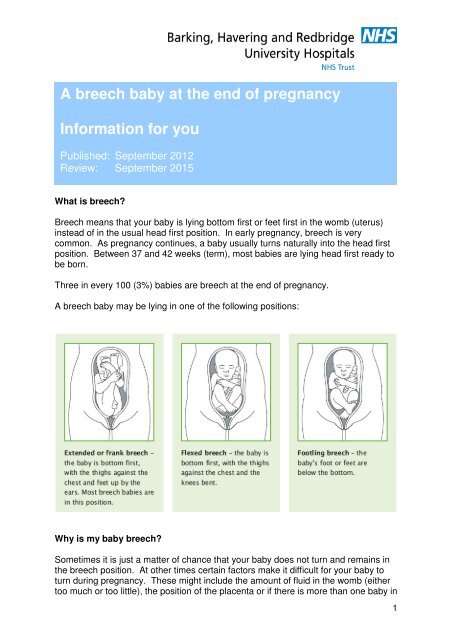
![[4] Biopsy Leaflet.pub - Barking, Havering and Redbridge University ...](https://img.yumpu.com/51285530/1/190x134/4-biopsy-leafletpub-barking-havering-and-redbridge-university-.jpg?quality=85)

